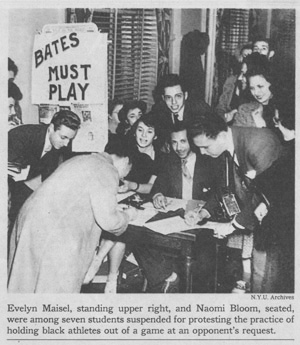It all started in November of 1940 when the University of Missouri asked New York University to bench Leonard Bates, a black fullback for NYU. Seven students brought the matter up at a student council meeting. Those students decided to protest against the university’s discrimination against black athletes. This particular case was called the “gentlemen’s agreement,” where northern integrated schools agreed to bench black athletes while playing segregated schools in the south at the opponent’s request. The protest contained 2,000 students and 4,000 signatures on a petition. Following the protest, the seven students were suspended for three months in March of 1941, changing their forever. Sixty years later, NYU honored Evelyn Maisel Witkin, Anita Krieger Appleby, Jean Borstein Azulay, Argyle Stoute, Naomi Bloom Rothschild, Robert Shoenfeld, and Mervyn Jones for their dedication to social justice.
It took six decades for the Bates seven to get the recognition they deserved. These individuals had given up expecting anything to happen. Although the seven had been acknowledged with a tribute because they suffered for what they believed in, they never received an apology. The acknowledgment is a result of a letter-writing campaign begun by one of the seven, Ms. Witkin. The former students had been recognized at NYU during an awards banquet for present-day athletes.
There had been an article here and there about this event, such as the ‘End Jim Crow in Sports’: The Protest at New York University, 1940-1941, published in 1988 by Donald Spivey. Many statements were published in the Washington Square College Bulletin Newspaper, which caused a clash between the administration and the students. The video coverage didn’t come until 2001, when the seven were recognized. Social media had not been created until 1997, and even then, it wasn’t a big thing. Many of the more popular newspaper articles were not published until 2001, nearing or following the banquet. For example, Edward Wong published an article on May 4, 2001, titled, “NYU Honors Protesters It Published in ‘31”. This article had a tremendous impact and created a buzz outside of NYU which informed many people of this untasteful event. This article was also covered by ABC, NBC, and CBS local affiliates. None of this coverage came until 60 years later.
This movement also included discrimination against Jim Coward. He was a transfer basketball player that played for two years at Brooklyn College before being declared ineligible upon transferring to the School of Education at NYU. The students believed this was due to the gentlemen’s agreement, but the school had argued that he was short of the required credits to participate. This event was followed by in February of 1941 when NYU agreed to leave behind three African American members of the track team before a meet with Catholic University.

Here is a clip of the students obtaining signatures for their petition.

Leave a Reply